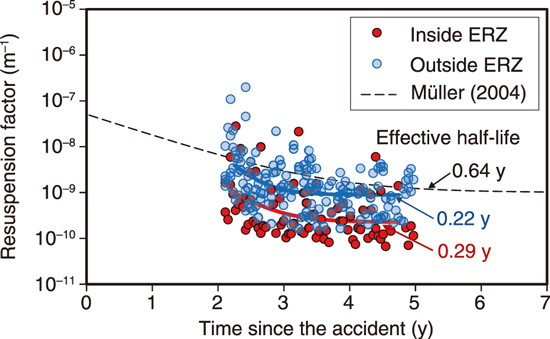Radioactivity and Air Dose Rate
(2024)
QHow has the cesium concentration in the air changed since the accident?
AThe temporal changes in atmospheric 137Cs concentrations measured at four sites outside the entry-restricted zone (ERZ) indicated a decreasing trend at all sites. Additionally, the atmospheric 137Cs concentration decreased rapidly five years after the 1F accident because of decontamination and was reduced to about half of the previous year’s value.
The atmospheric 137Cs concentrations have been monitored continuously to assess the internal exposure of residents after the TEPCO’s Fukushima Daiichi NPS (1F) accident in March 2011. Evaluation of the resuspension factor (RF) is effective for assessing the internal exposure over a broad area because the atmospheric 137Cs concentration can be easily estimated from the 137Cs deposited on the ground surface, for which information is easily obtained over a broad area.
In this study, to evaluate the characteristics of the long-term variation trend of RF, we analyzed the results of atmospheric 137Cs concentration, which were continuously monitored and published by the Nuclear Regulation Authority (NRA) since the 1F accident. The influence of anthropogenic activities was assessed by comparing data obtained inside and outside the entry-restricted zone (ERZ), where human access is restricted.
The data used in this study were the data on atmospheric 137Cs concentrations at two sites within the ERZ and four sites outside the ERZ, obtained between May 2013 and November 2017. The 137Cs deposition on the ground surface was based on the data from the distribution map of 137Cs deposition, which was re-evaluated based the 3rd Airborne Radiological Survey.

Fig. 1 Temporal changes in atmospheric 137Cs concentrations
The temporal changes in atmospheric 137Cs concentrations measured at four sites outside the entry-restricted zone (ERZ) indicated a decreasing trend at all sites. Additionally, the atmospheric 137Cs concentration decreased rapidly five years after the 1F accident because of decontamination and was reduced to about half of the previous year’s value.

Fig. 2 Temporal changes in the resuspension factor (RF) and effective half-life
The resuspension factor (RF; i.e., the ratio of dispersion from the ground surface to the air) before decontamination decreased faster outside the ERZ (0.22 years) than inside ERZ (0.29 years) and faster in Fukushima than during the Chernobyl accident (0.64 years), when compared in terms of the effective half-life (i.e., the time for the concentration to be halved).
Atmospheric 137Cs concentrations showed a decreasing trend over time at all sites during the observation period. In particular, 137Cs concentrations outside ERZ probably decreased rapidly after five years after the 1F accident because of the effect of decontamination (Fig.1). To evaluate the influence of anthropogenic activities other than decontamination, we compared the trend of RF variation over the period from two years after the accident to five years after the accident before decontamination was performed, by fitting an exponential model (Fig.2).
A comparison of the situations inside and outside the ERZ showed that the RF was higher and the effective half-life was smaller outside the ERZ. Within the ERZ, the main driver of resuspension is only natural phenomena such as wind; in contrast, outside the ERZ, the impact of anthropogenic activity is more remarkable, and therefore, the resuspended component is likely to reduce more rapidly by anthropogenic activity.
We also compared the variation trends of the RF values obtained in this study with the previously reported results related to the Chornobyl accident (Fig.2). The half-life of the Fukushima RF modeled in this study was found to be shorter than that of Müller’s* results, which were fitted by the same exponential model as in this study, especially outside ERZ.
These findings are considered important for determining the parameters for internal exposure assessment.
*Müller, H. et al., Model Description of the Terrestrial Food Chain and Dose Module FDMT in RODOS PV6.0, RODOS(RA3)-TN(03)06, 2003, 55p.
